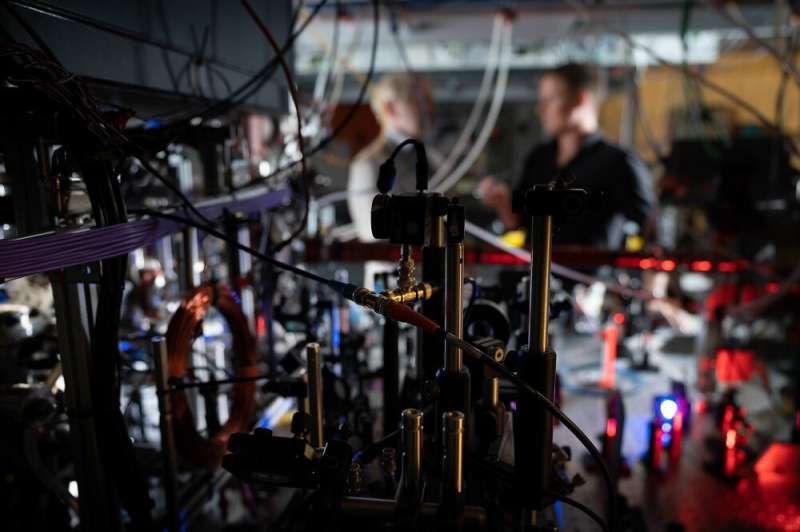Invisible helium atoms provide exquisitely sensitive test of fundamental theory

Physicists at the Australian National University have developed the most sensitive method ever for measuring the potential energy of an atom (within a hundredth of a decillionth of a joule—or 10-35 joule), and used it to validate one of the most tested theories in physics—quantum electrodynamics (QED).
The research, published this week in Science relies on finding the color of laser light where a helium atom is invisible, and is an independent corroboration of previous methods used to test QED, which have involved measuring transitions from one atomic energy state to another.
“This invisibility is only for a specific atom and a specific color of light—so it couldn’t be used to make an invisibility cloak that Harry Potter would use to investigate dark corners at Hogwarts,” said lead author, Bryce Henson, a Ph.D. student at ANU Research School of Physics.
“But we were able to use to investigate some dark corners of QED theory.”
“We were hoping to catch QED out, because there have been some previous discrepancies between theory and experiments, but it passed with a pretty good mark.”
Quantum Electrodynamics, or QED, was developed in the late 1940s and describes how light and matter interact, incorporating both quantum mechanics and Einstein’s special theory of relativity in a way that has remained successful for nearly eighty years.
However, hints that QED theory needed some improvement came from discrepancies in measurements of the size of the proton, which were mostly resolved in 2019.
Around this time ANU Ph.D. Scholar Bryce Henson noticed small oscillations in a very sensitive experiment he was conducting on an ultracold cloud of atoms known as a Bose-Einstein condensate.
He measured the frequency of the oscillations with record precision, finding that interactions between the atoms and the laser light changed the frequency, as the laser color was varied.
He realized this effect could be harnessed to very accurately determining the precise color at which the atoms did not interact at all with the laser and the oscillation remained unchanged—in other words effectively becoming invisible.
With the combination of an extremely high-resolution laser and atoms cooled to 80 billionths of a degree above absolute zero (80 nanokelvin) the team achieved a sensitivity in their energy measurements that was 5 orders of magnitude less than energy of the atoms, around 10–35 joules, or a temperature difference of about 10-13 of a degree kelvin.
“That’s so small that I can’t think of any phenomenon to compare it to—it’s so far off the end of the scale,” Mr Henson said.
With these measurements the team were able to deduce very precise values for the invisibility color of helium. To compare their results with theoretical prediction for QED, they turned to Professor Li-Yan Tang from the Chinese Academy of the Sciences in Wuhan and Professor Gordon Drake from the University of Windsor in Canada.
Previous calculations using QED had less uncertainty than the experiments, but with the new experimental technique improving the accuracy by a factor of 20, the theoreticians had to rise to the challenge and improve their calculations.
In this quest they were more than successful—improving their uncertainty to a mere 1/40th of the latest experimental uncertainty, and singling out the QED contribution to the atom’s invisibility frequency which was 30 times larger than the experiment’s uncertainty. The theoretical value was only slightly lower than the experimental value by 1.7 times the experimental uncertainty.
Leader of the international collaboration, Professor Ken Baldwin from the ANU Research School of Physics, said that improvements to the experiment might help resolve the discrepancy, but would also hone an extraordinary tool that could illuminate QED and other theories.
“New tools for precision measurements often drive big changes in theoretical understanding down the track,” Professor Baldwin said.
JILA atomic clocks measure Einstein’s general relativity at millimeter scale
B. M. Henson et al, Measurement of a helium tune-out frequency: an independent test of quantum electrodynamics, Science (2022). DOI: 10.1126/science.abk2502
Citation:
Invisible helium atoms provide exquisitely sensitive test of fundamental theory (2022, April 8)
retrieved 8 April 2022
from https://phys.org/news/2022-04-invisible-helium-atoms-exquisitely-sensitive.html
This document is subject to copyright. Apart from any fair dealing for the purpose of private study or research, no
part may be reproduced without the written permission. The content is provided for information purposes only.
For all the latest Science News Click Here
For the latest news and updates, follow us on Google News.

